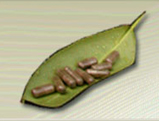 Sanskrit name: Chandan
Sanskrit name: Chandan
Botanical name: Pterocarpus Santalinus
Habitat: This is a lofty forest tree. The leaves are alternate, stalked, ternate, and rarely pinnate; the leaflets alternate, petiolate, the uppermost larger, ovate-roundish or oblong, entire, emarginate or retuse, smooth above, and hoary beneath; the stipules wanting. The flowers are yellow, with red veins, papilionaceous, and borne in axillary, simple or branched, erect racemes. Bracts none. Calyx brown and 5-cleft. Stamens 10, combined into a sheath, split down to the base on the upper side, and half-way down on the lower. The legume is roundish, long-stalked, and falcate upward, compressed, smooth, and keeled on the lower edge; the keel is membranous and undulated. Seed solitary (L.).
Energetics:
- Rasa (taste): Bitter, Sweet
- Virya (action): Cooling
- Vipaka (post-digestive effects): Pungent
- Dosha (constitution): Balances pitta and vata, increases kapha
General information
Red sandalwood or Rakta Chandana is considered holy as per Hindu mythology and is used in several religious ceremonies. It is also used as one of the Rasayna, the aroma of sandalwood helps relax the mind and rejuvenates it. Because of its cooling action on virya, it helps in pacifying pitta dosha thus helping in the treatment of gastrointestinal disorders.

 Loading... Please wait...
Loading... Please wait...













